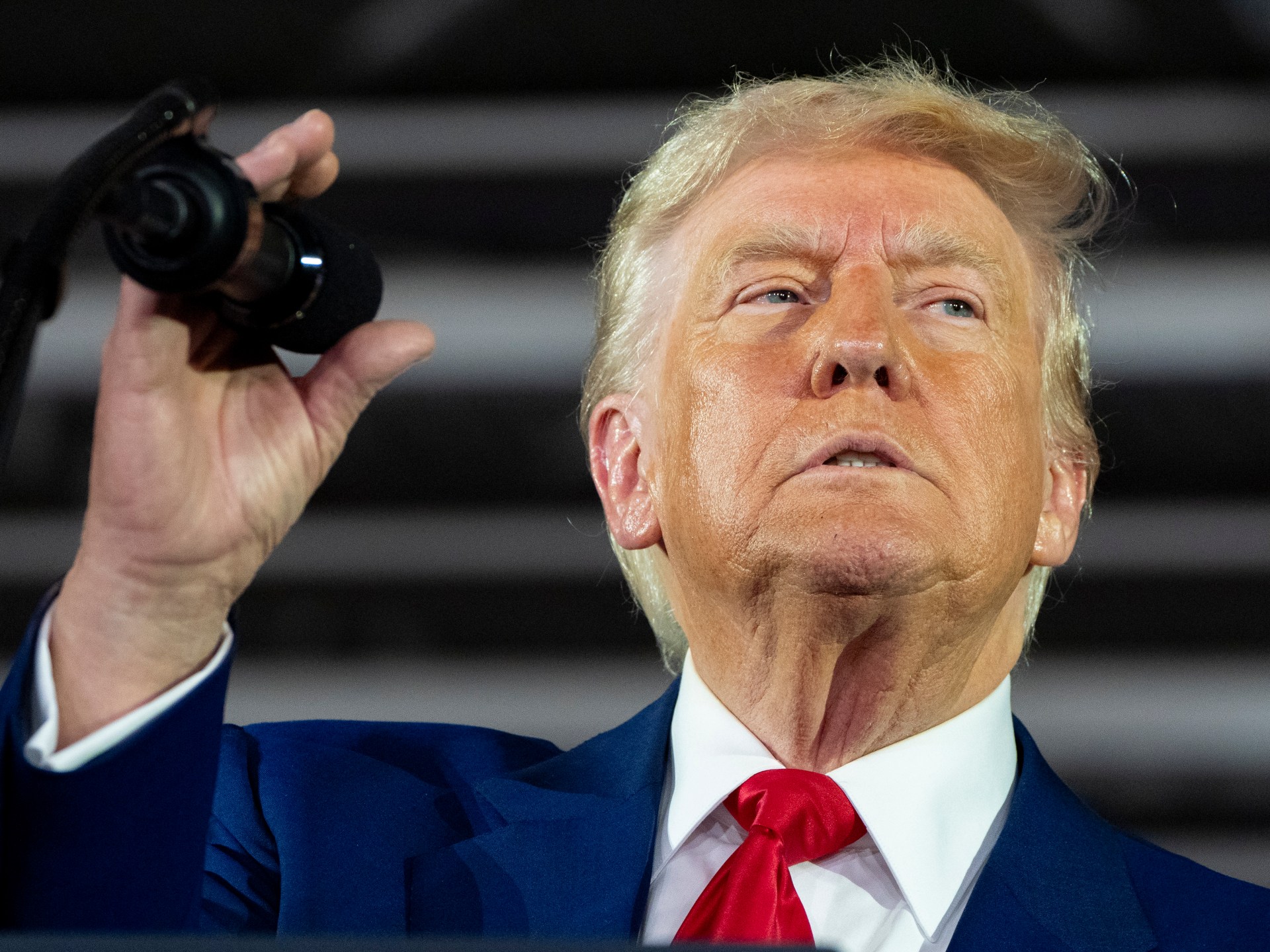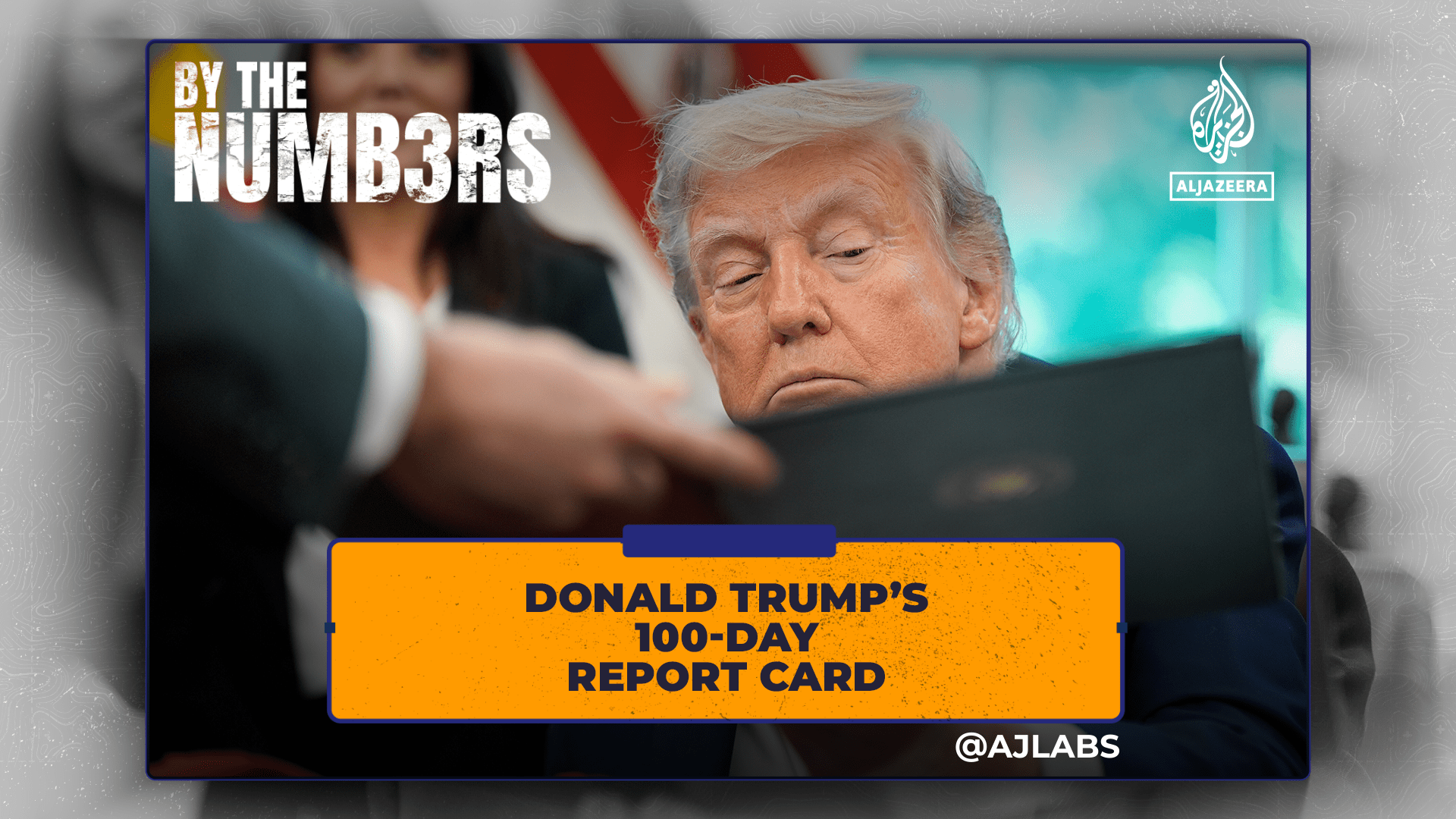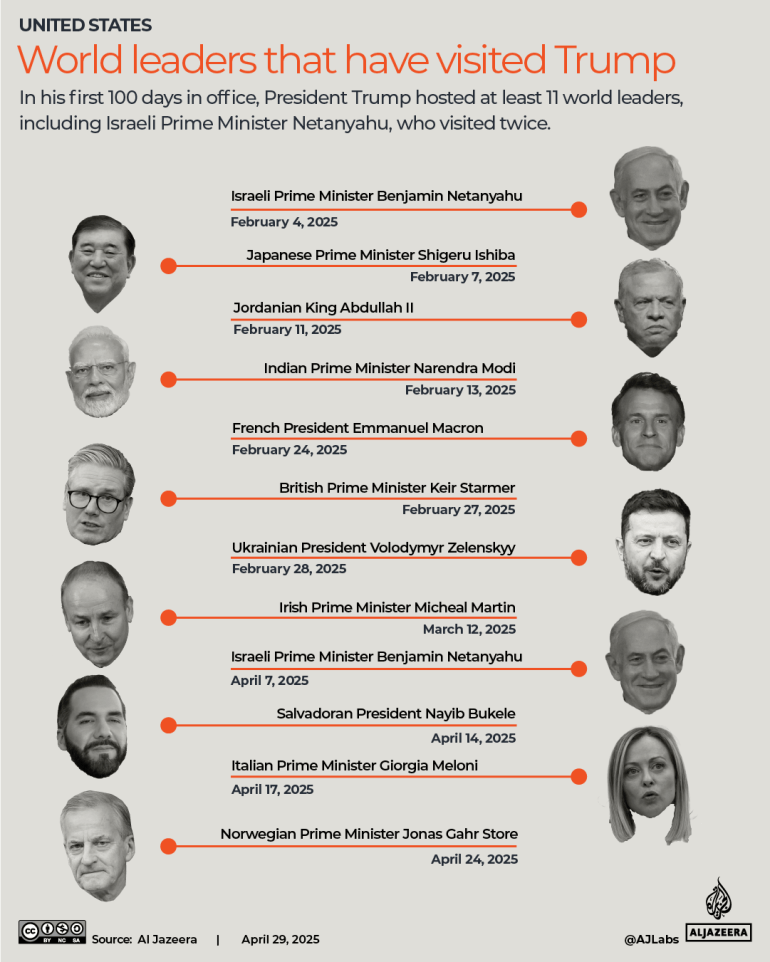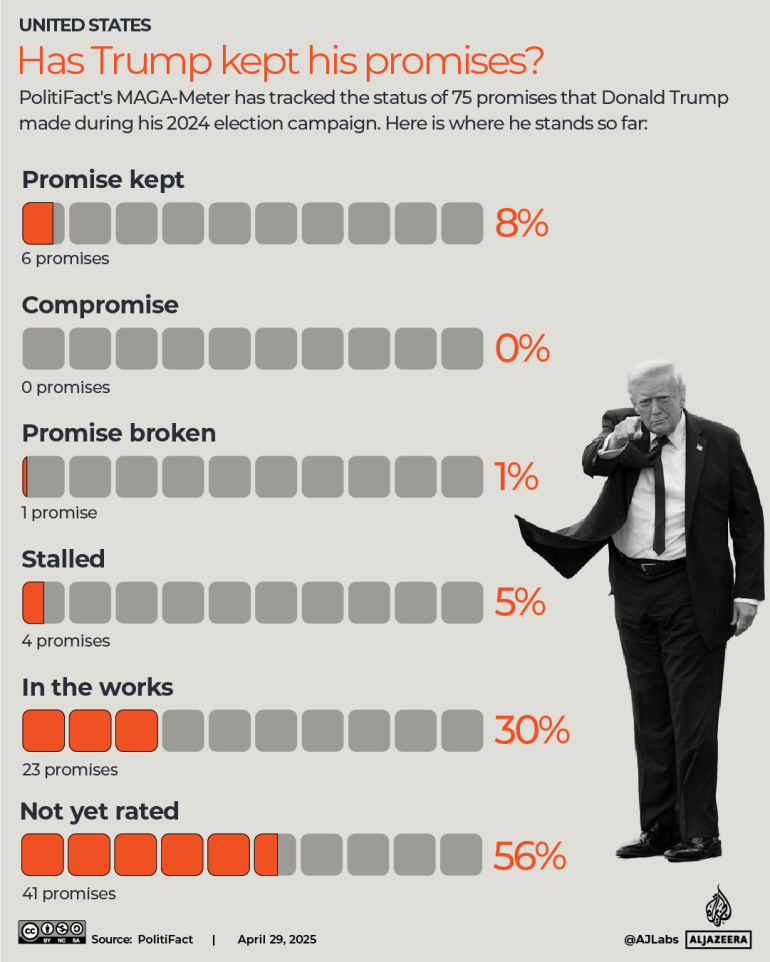Fact-checking Trump’s claims at 100-day rally in Michigan | Donald Trump News
Donald Trump’s speech in Warren, Michigan, marking his 100th day in office sounded a lot like something the United States president clearly loves: a good old-fashioned campaign rally.
During the April 29 speech, Trump touted a record number of executive orders, efforts to slash the federal workforce and deportations of migrants in the US illegally, spotlighted in a video showing deportees being booked into a high-security El Salvador prison.
But Trump also returned to themes that animated his campaign rallies and looked for familiar faces in the crowd. “I missed you guys. I missed the campaign,” he said. Trump referred to his predecessor, former President Joe Biden, on several occasions, once polling the audience: “What’s a better name for us to call him, ‘Sleepy Joe’ or ‘Crooked Joe?’”
With polls showing falling approval ratings, Trump took a sustained shot at the surveys, calling them “fake” and saying if the polls were honest, his approval ratings would “be in the 60s or 70s”.
Five polls released in the run-up to Trump’s 100th day – from CBS News, CNN, The New York Times/Siena, ABC News/Washington Post and NPR/PBS/Marist – found Trump’s approval ratings between 42 percent and 45 percent.
Here, we fact-checked several of Trump’s statements.
Trump said he ‘restored free speech’ but his actions tell a different story
Trump said, “I banned all government censorship and restored free speech in America. We have free speech.” Trump’s administration repeatedly took action against people and organisations exercising their right to free speech, including the news media, universities and students who participated in activism about Israel’s war on Gaza.
“President Trump has certainly not brought back free speech in America,” said Nico Perrino, executive vice president of the Foundation for Individual Rights and Expression, an organisation that defends free speech for people and groups on both sides of the political spectrum.
“In fact, since Inauguration Day, we have seen some of the most significant threats to free speech in recent memory.”
Several judges have also said or written in rulings that the administration has violated free speech, including in a case filed by The Associated Press after its journalists were barred from White House events because the organisation didn’t refer to the Gulf of Mexico as the “Gulf of America”.
A federal judge ruled in the AP’s favour, saying, “The AP’s exclusion has been contrary to the First Amendment,” and instructing the government to stop “continuing down that unlawful path”.
Trump says illegal border crossings are lowest ‘ever recorded’
Trump said, “We’ve set all-time records for the lowest number of illegal border crossings ever recorded.”
This needs context. Monthly border data has been collected only since 2000.
Immigration at the US southern border has dropped notably during the first few months of the Trump administration.
Immigration officials encountered migrants at the southern border about 8,300 times in February and about 7,200 times in March. Those border encounters are the lowest number of monthly crossings by undocumented immigrants between ports of entry since Border Patrol began reporting monthly data. Officials recorded 11,000 encounters in April 2020, the previous low, during the COVID-19 pandemic during Trump’s first term.
Before 2000, data was reported annually. We took that annual federal data and divided it by 12 to find an average monthly figure. Based on those calculations, average monthly apprehensions were below 6,100 from 1961 to 1968.
Wholesale egg prices have fallen, but consumers haven’t experienced relief yet
Trump said egg prices – a consumer concern in recent months – have fallen by 87 percent on his watch. This is half true: wholesale prices have fallen (though not by as much as Trump says) but the decline has not yet affected retail prices.
During the Biden administration, more than 100 million egg-laying chickens died from bird flu or were killed to stop the virus’s spread. Flock-culling is standard practice employed by presidents in both political parties for addressing bird flu. But the Biden-era prevention measure led to egg shortages and higher prices. That continued into the Trump presidency.
The wholesale price of a dozen eggs peaked at $8.07 on February 21. Since then, it’s fallen 61 percent, to $3.15.
However, the most recent data for retail prices – what consumers pay at the store – showed a dozen eggs cost $6.23 in March. The April figures could show a reduction in retail prices, but the data isn’t in yet.
Gasoline prices have fallen, but not as substantially as Trump says
In Michigan, and on several previous occasions, Trump said gas is selling for $1.98 per gallon (3.8 litres) in some states. This is false.
When he said this April 22, we found the lowest statewide price was $2.66 per gallon, and the national average was about $3.14. Data from the federal government and the American Automobile Association shows no significant shift since then.
GasBuddy.com data from April 23 showed that no gas station out of roughly 150,000 nationally sold gasoline for $1.98 per gallon.
Trump touts auto investments, but they could take time to bear fruit
With one exception, the White House’s auto-related announcements were investment reallocations at existing facilities, not plants being built. Building a plant, or increasing production at an existing plant, can take years, and plans can be modified or disappear entirely.
In some cases, experts said, companies might publicly announce plans to curry favour with Trump, even if they had intended to make these investments all along.
Greig Mordue, a McMaster University manufacturing policy professor, said carmakers such as Hyundai, Honda and Stellantis are likely preparing to accelerate already decided launches to adapt to political realities. “Those launches can be positioned as ‘wins’” for Trump, Mordue said.
Trump: ‘We’re slashing billions and billions of dollars in waste, fraud and abuse’
The federal government has cut costs under Trump, but he has not proven that he cut billions in fraud.
The Department of Government Efficiency, known as DOGE, website says it saved $160bn, a fraction of the $2 trillion that billionaire businessman Elon Musk, who leads the effort, once promised to cut.
The Partnership for Public Service, a nonprofit whose mission is to improve the federal government, said DOGE has cost the federal government roughly $135bn. The organisation based that figure on $270bn in annual workforce compensation and then estimated that layoffs, buyouts, hiring freezes and other changes reduced productivity by 50 percent. The figures do not include the cost of defending lawsuits.
Trump and Musk repeatedly said they have uncovered “fraud,” but largely pointed to projects that they disagree with ideologically, such as efforts on diversity, equity and inclusion, or climate change.
An expiration of Trump’s 2017 tax cuts could be a large hit to taxpayers
Trump said, “If the Democrats prevail on this bill, you get a 58 percent tax increase.” Taxes would go up if the tax cuts from Trump’s 2017 tax bill expire – but Democrats aren’t opposed to continuing Trump’s tax cuts for households earning less than $400,000, only for households earning more than that.
Trump is correct that if Congress doesn’t pass an extension, taxpayers would take a big hit. We rated mostly true a statement by Representative Mike Lawler from New York, that “if we don’t pass the tax bill by the end of the year, we will have the largest tax increase in American history.”
By some estimates, allowing the tax cuts to expire would result in the single most significant tax increase by dollar amount in history, an estimated $4.6 trillion revenue increase over a decade, from fiscal year 2025 to 2034, including interest.
Trump asked: ‘Who the hell would work at home?’ Here’s what we know about remote workers
US Census Bureau data from 2023 shows that about two-thirds of home-based workers in the US were white and the median age was 43.5 years old.
Women represented 52.3 percent of people who worked from home and men 47.7 percent. The New York Times reported mothers of young children are more likely to work remotely than women without children or women with older children.
Trump IDs wrong lawmaker who proposed impeachment
Early in his remarks, Trump said, “This country has gone crazy. And today they did it again. Some guy that I never heard of, John James. Is he a congressman? This guy? He said, he said, ladies and gentlemen, I am going to start the impeachment of Donald Trump.”
A Michigan lawmaker this week proposed impeaching Trump, but it wasn’t Republican Representative John James. It was Democratic Representative Shri Thanedar.
James is running for governor of Michigan, hoping to succeed Democrat Gretchen Whitmer.
Brian Pannebecker, a Trump supporter who the president asked to address the crowd, correctly identified Thanedar as the lawmaker proposing impeachment.
And Trump later in his speech correctly identified James, saying, “Luckily, right now, we’ve got good people in Congress, like Congressman John James over here.”
Trump said he ‘brought back’ Columbus Day. Did it ever go away?
Trump said, “Just yesterday I brought back Columbus Day in America.”
His April 28 Truth Social post said he is “hereby reinstating Columbus Day under the same rules, dates, and locations, as it has had for all of the many decades before!”
Trump appears to be referencing a 2021 proclamation in which Biden acknowledged the “significant sacrifices made by Native peoples to this country – and recognise their many ongoing contributions to our Nation”.
However, while some states have recognised Indigenous People’s Day either instead of or in addition to Columbus Day on the same day in October, there was no change in the federal holiday under Biden. It remains a federal holiday. Biden issued a Columbus Day proclamation in 2024.
Trump: ‘We find out that whoever operated the autopen was the real president’
We fact-checked a similar statement by Trump about Biden using autopens to sign pardons.
The Constitution doesn’t require that pardons be signed directly by the president; the use of a mechanical device for signatures is not prohibited.
Biden was not the first US president to use an autopen. Presidents Barack Obama, John F Kennedy and Thomas Jefferson used autopens or mechanised signing devices.
When we asked the White House in March whether Trump ever used an autopen, a spokesperson pointed to Trump’s comments, when he said, “I never use it. I mean, we may use it, as an example, to send some young person a letter, because it’s nice. … But to sign pardons and all of the things that (Biden) signed with an autopen is disgraceful.”




